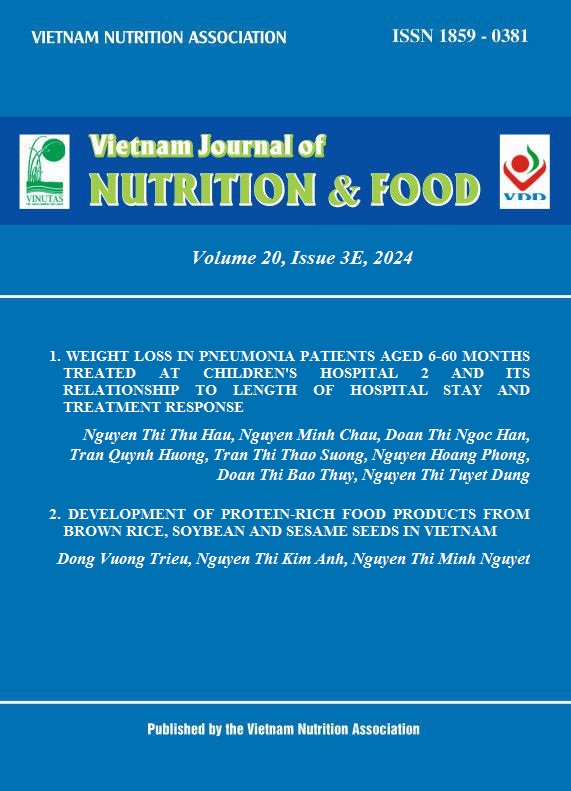DEVELOPMENT OF PROTEIN-RICH FOOD PRODUCTS FROM BROWN RICE, SOYBEAN AND SESAME SEEDS IN VIETNAM
Nội dung chính của bài viết
Tóm tắt
Từ khóa
Thanh dinh dưỡng, dinh dưỡng, gia tốc nhiệt, hạn sử dụng, ngũ cốc nguyên hạt, đậu nành rang, gạp lứt phồng
Chi tiết bài viết
Tài liệu tham khảo
2. Ravichanthiran K, Ma ZF, Zhang H, et al. Phytochemical profile of brown rice and its nutrigenomic implications. 2018;7(6):71: 2076-3921.
3. Abbas S, Sharif MK, Sibt-e-Abbas M, et al. Nutritional and therapeutic potential of sesame seeds. 2022;2022:1-9.
4. Chen K-I, Erh M-H, Su N-W, et al. Soyfoods and soybean products: from traditional use to modern applications. 2012;96:9-22.
5. Ananthan P, Sharma GK, Semwal AD. Energy bars: A perfect choice of nutrition to all. In: Advances in Processing Technology. CRC Press; 2021:309-332. doi: 10.1201/9781003245513.
6. Singh U, Joshi S, Verma M. Development of gluten-free energy bars. The Pharma Innovation Journal. 2022. ISSN: 2277-7695.
7. Lu N, Zhou P. Whey protein-based nutrition bars. In: Whey Proteins. Elsevier; 2019:495-517.
8. Van Toan N, Vinh TQ. Production of nutritional bars with different proportions of oat flour and brown rice flour. Clinical Journal of Nutrition and Dietetics. 2018;1(1):1-11.
9. Umme H, Ashadujjaman RM, Mehedi HM, et al. Nutritional, textural, and sensory quality of bars enriched with banana flour and pumpkin seed flour. Foods and Raw materials. 2021;9(2):282-289. doi: 10.21603/2308-4057-2021-2-282-289.
10. Salitlertthanasin P. Product development of Thai rice cereal (Khao-Mao) bar with garlic flavor and its shelf-life using accerelated method. 2017. Bangkok, Thailand: Assumption University, BSc special project.
11. Allai FM, Dar B, Gul K, et al. Development of protein rich pregelatinized whole grain cereal bar enriched with nontraditional ingredient: Nutritional, phytochemical, textural, and sensory characterization. Frontiers in Nutrition. 2022;9. doi: 10.3389/fnut.2022.870819.
12. Sumczynski D, Bubelova Z, Sneyd J, et al. Total phenolics, flavonoids, antioxidant activity, crude fibre and digestibility in non-traditional wheat flakes and muesli. Food chemistry. 2015;174:319-325. doi: 10.1016/j.foodchem.2014.11.065.
13. Su‐Ah J, Ahmed M, Eun JB. Physicochemical characteristics, textural properties, and sensory attributes of low‐calorie cereal bar enhanced with different levels of saccharin during storage. Journal of Food Processing and Preservation. 2018;42(2):e13486. doi: 10.1111/jfpp.13486.
14. Upadhyay A, Karn SK. Brown rice: Nutritional composition and health benefits. Journal of Food Science and Technology Nepal. 2018;10:47-52. ISSN: 1816-0727. doi: 10.3126/jfstn.v10i0.19711.
15. Etiosa OR, Chika NB, Benedicta A. Mineral and proximate composition of soya bean. Asian Journal of Physical and Chemical Sciences. 2017;4(3):1-6. doi: 10.9734/AJOPACS/2017/38530.
16. Suryana A, Rosiana N, Olivia Z. Effect of drying method on the chemical properties of local soy flour. Paper presented at: IOP Conference Series: Earth and Environmental Science 2022. doi: 10.1088/1755-1315/980/1/012030.
17. Boge EL, Boylston TD, Wilson LA. Effect of cultivar and roasting method on composition of roasted soybeans. Journal of the Science of Food and Agriculture. 2009;89(5):821-826. doi: 10.1002/jsfa.3519.
18. Wei P, Zhao F, Wang Z, et al. Sesame (Sesamum indicum L.): A comprehensive review of nutritional value, phytochemical composition, health benefits, development of food, and industrial applications. Nutrients. 2022;14(19):4079. doi: 10.3390/nu14194079.
19. Vangaveti VN, Jansen H, Kennedy RL, et al. Hydroxyoctadecadienoic acids: Oxidised derivatives of linoleic acid and their role in inflammation associated with metabolic syndrome and cancer. European journal of pharmacology. 2016;785:70-76. doi: 10.1016/j.ejphar.2015.03.096.
20. Jovanov P, Sakač M, Jurdana M, et al. High-protein bar as a meal replacement in elite sports nutrition: a pilot study. Foods. 2021;10(11):2628. doi: 10.3390/foods10112628.
21. NA ZA, Abdullah M, Rusli N, et al. Physicochemical properties and sensory acceptance of canavalia ensiformis tempeh energy bar. Food Research. 2020. doi: 10.26656/fr.2017.4(5).150.
22. Mridula D, Singh K, Barnwal P. Development of omega-3 rich energy bar with flaxseed. Journal of Food Science and Technology. 2013;50(5):950-957. doi: 10.1007/s13197-011-0425-x.
23. Eke-Ejiofor J, Okoye C. Nutrient composition, lipid profile and sensory properties of cereal bar made from locally available cereals and nuts. International Journal of Biotechnology and Food Science. 2018;6(1):1-8.
24. Quang BH, Duy ĐT. Nghiên cứu thanh hạt ăn liền bổ sung hạt chanh dây. Tạp chí Khoa học Trường Đại học Cần Thơ. 2021;57(3):106-113. doi: 10.22144/ctu.jvn.2021.091.
25. Drewnowski A. Concept of a nutritious food: toward a nutrient density score. The American journal of clinical nutrition. 2005;82(4):721-732. doi: 10.1093/ajcn/82.4.721.
26. Padmashree A, Negi N, Haridas S, et al. Development and quality evaluation of choco quinoa nutri bar during storage. Food and Nutrition Sciences. 2018;9(7):899-914.
27. Loveday SM, Hindmarsh JP, Creamer LK, et al. Physicochemical changes in a model protein bar during storage. Food Research International. 2009;42(7):798-806.
28. Jiang Z, Wang K, Zhao X, et al. High-protein nutrition bars: Hardening mechanisms and anti-hardening methods during storage. Food Control. 2021;127:108127. doi: 10.1016/j.foodcont.2021.108127.
29. Barden L, Decker EA. Lipid oxidation in low-moisture food: A review. Critical reviews in food science and nutrition. 2016;56(15):2467-2482. doi: 10.1080/10408398.2013.848833.
30. Afifah DN, Ningrum YPA, Syahidah T, et al. Nutrient content, organoleptic quality, and shelf life of sagon substitute from lindur (bruguiera gymnorrhiza L.) and soybean flour (glycine max L.), as an alternative emergency food. Frontiers in Nutrition. 2022:689. doi: 10.3389/fnut.2022.878539.
31. Padmashree A, Sharma GK, Srihari KA, et al. Development of shelf stable protein rich composite cereal bar. Journal of food science and technology. 2012;49:335-341.
32. Sarika K, Jayathilakan K, Lekshmi R, et al. Omega-3 enriched granola bar: Formulation and evaluation under different storage conditions. Fishery Technology. 2019;56:130-139.
33. Mendes NdSR, Gomes-Ruffi CR, Lage ME, et al. Oxidative stability of cereal bars made with fruit peels and baru nuts packaged in different types of packaging. Food Science and Technology. 2013;33:730-736.


